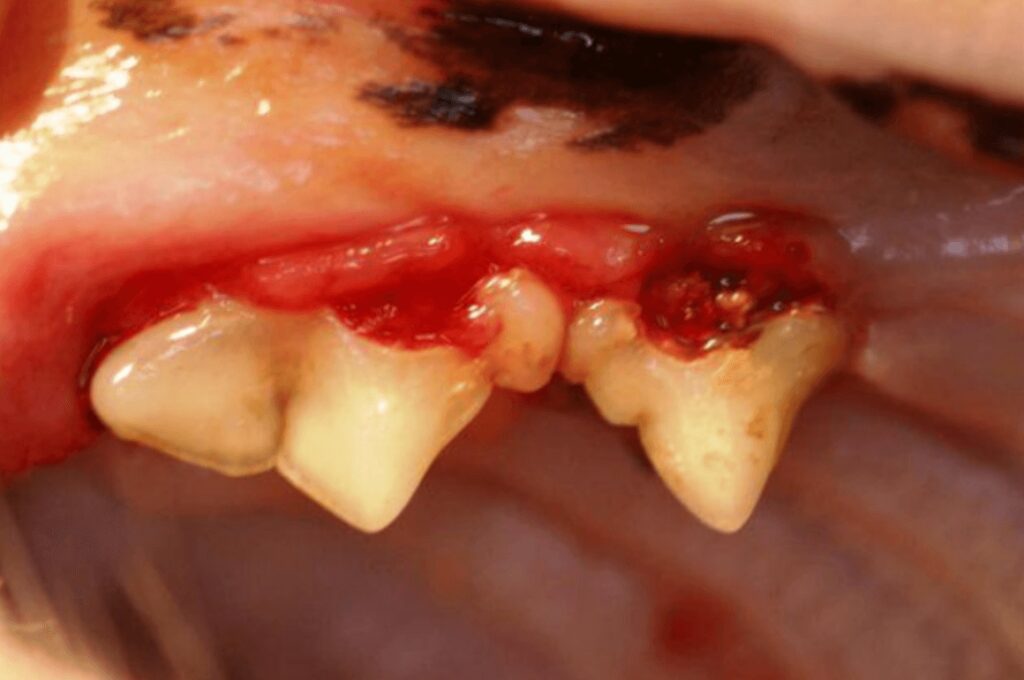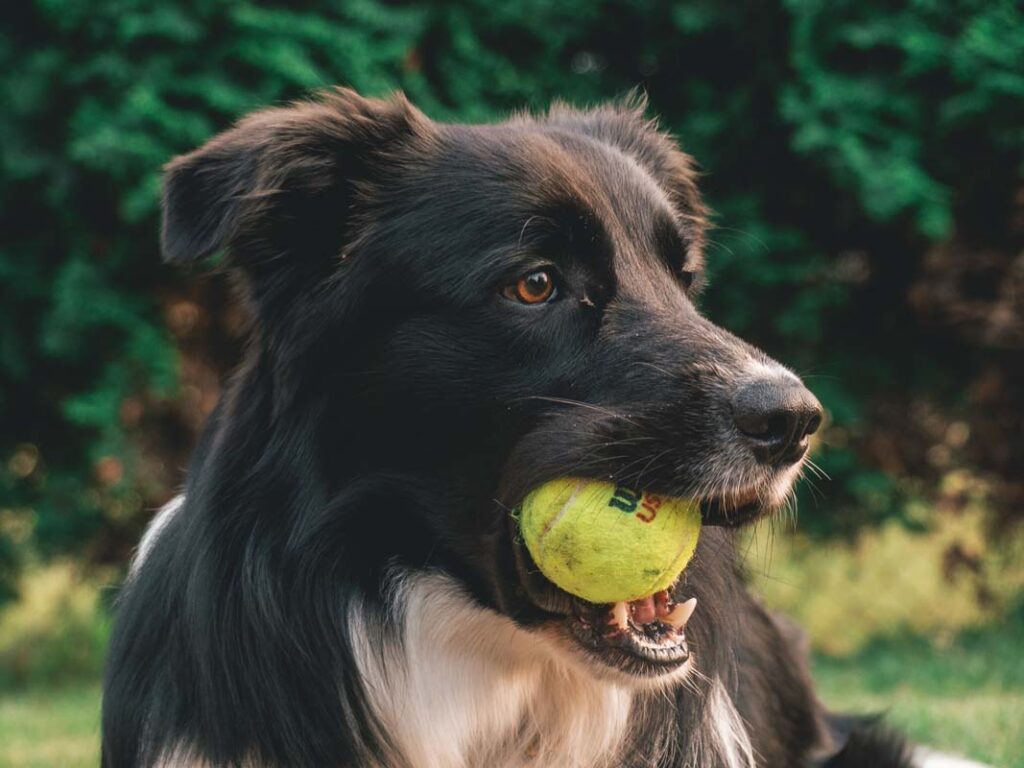In honor of Veterinary Dental Disease Awareness Month, I have created a 2-part series on Dental Disease. Did you know that ALL cats and dogs have some degree of dental disease by the age of 3!! And did you also know that the vast majority of pet owners are unaware of what dental disease looks like? In this 2-part series, we will dig into what dental disease is, what causes it, and how to prevent and treat this stinky problem.
#1: How does my pet get Dental Disease?
Dental Disease is a condition that typically results from poor dental hygiene. Think about it….when was the last time your dog or cat brushed/flossed/gargled Listerine? Effective dental hygiene in dogs is nearly impossible and absolutely impossible in cats. I hate to the be the bearer of bad news, however, the extra fee you pay for your dogs’ or cats’ teeth to get brushed at their routine grooming appointment isn’t worth the money you are spending. If you brushed your teeth every 4-6+ weeks in hopes of preventing dental disease, do you think you would succeed? Probably not.
Outside of poor dental hygiene, we do know that certain breeds are genetically predisposed to dental disease. The first breed that comes to mind is Greyhound! Generally speaking, we also know that small breed dogs do tend to have more problems with dental disease compared to larger breed dogs.
In cats, we do see a very frustrating form of dental disease caused Resorptive Dental Disease. This condition is still unknown as to WHY it happens, but we do see it most commonly in cats vs dogs. In this form of dental disease, the cat’s body seems to digest the tooth causing cavity-like lesions that are extremely painful, until the tooth disintegrates/falls out.
Stage 4 Periodontal Disease in a Dog

Resorptive Dental Lesion in a Cat

#2: How do I know if my Cat or Dog has Dental Disease?
This can be tough. In the 1st picture above displaying severe dental disease, this would be kinda hard to miss at home as your pet would have HORRIBLE breath, have a tough time chewing hard food, and would also likely refuse to play tug-o-war / chewy toys due to severe dental pain. In the 2nd picture of a cat with Resorptive Dental Disease, you most likely would not notice much change in your pet at home. The vast majority of cats will still eat despite having this sharp dental pain. Sometimes you may notice bad breath, other times, not so much. Really, the true way to know what is going on in your pet’s mouth is to have your trusted veterinarian perform an oral exam. And honestly, even then, there are A LOT of critters that simply won’t tolerate a thorough oral exam. Usually, I am pretty happy if I can catch a quick glimpse of my patient’s mouth while lifting a lip! In these cases, usually, the majority of the oral exam and diagnosis is made while they are under anesthesia at the time of a dental cleaning.
#3: When should I consider having my pet’s teeth cleaned?
Have you ever heard of the old saying, “An ounce of prevention is worth a pound of cure”? This couldn’t be truer when applied to dental cleanings in our pets. In all honesty, having an annual prophylactic dental cleaning is one of the best ways to prevent dental disease in the future. The vast majority of my clients elect to forego the annual dental prophy because they do not perceive value in prevention. They usually wait until dental disease is in full effect and we use a dental as a treatment for a disease, rather than a preventative act. At this point, pets with full-blown dental disease are on a slippery slope to losing a lot of teeth, having a hefty dental surgery bill, and long term elevated dental care costs due to recurrent dental issues for the remainder of their lives.
Dental care is no different than annual preventive vaccines/stool exams/physical exams. We are recommending this level of health care because we know that it extends the vast majority of our beloved pets’ lives.
Below are pictures depicting the 4 stages of Periodontal disease. Periodontal disease is a condition that affects the connective tissues around the tooth. These structures are what quite literally holds the tooth in the jaw bone. Grade 1 is mild gingivitis, inflammation of the gingivae secondary to the plaque. Antiseptic dental wipes can be beneficial at this stage IF performed daily. This stage is REVERSIBLE. Grade 2 is moderate gingivitis secondary to tartar. At home care will not remove tartar as it is securely fastened to the tooth. Special dental tools/equipment are needed to remove tartar. This stage CAN be reversible with professional dental cleaning AND follow up diligent at home care. Grade 3 is severe gingivitis. Heavy tartar and cherry red gums are noted. Gingivae is now receding and roots of the tooth are becoming exposed. The disease is NON-REVERSIBLE. Grade 4 is a severe periodontal disease. Multitudes of surgical extractions are indicated. Bacteria and infection are now running through your pet’s bloodstream and affecting other internal organs. This stage is NON-REVERSIBLE.

#4: I don’t want to put my dog or cat under anesthesia for a dental cleaning. Can’t we clean their teeth while they are awake?
I understand the concern clients face when the word “anesthesia” is mentioned. Pet lovers are fearful of their seemingly normal critter not waking up from anesthesia for just a dental cleaning. Truth be told, there is always a risk when anyone or anything is placed under anesthesia. There is a risk in ANYTHING that we do! Think about it. Just placing your pet into a car for a ride to the vet or groomer or park puts that pet at risk. And honestly, that risk is MUCH higher than the risk of death under state-of-the-art anesthesia. The risk of getting into a car accident and your pet being injured is more likely than death from anesthesia. You are wearing a seat belt (hopefully!) and your pet isn’t! Pets are commonly injured in simple rear-end accidents as they are projectiles during an impact.
With that all said, there are precautions taken prior to administering anesthesia to our beloved pets to ensure that they are healthy enough to undergo anesthesia. Blood work is performed by the majority of veterinarians to access your pet’s organ function and blood cell counts. However, in advanced aged pets, chest x-rays and EKG are also considered prior to proceeding with anesthesia. These tests help determine if your pet is in good health regardless of age and a good candidate for anesthesia.
I wish we could perform effective dental cleanings on our pets without the aid of anesthesia. The reality is that we can not perform the level of cleaning necessary to provide a positive health benefit. You may be able to pop some tartar caps off on an awake animal, however, you are not cleaning below the gum line where all the plaque and bacteria are housed. Think about anesthesia-free dentals like washing your car with only a hose. It may look clean at first, but all the dirt/grim is still clinging to your car. Without soapy water, a cloth, and some elbow grease, you aren’t getting your car clean. Teeth are no different!
Bottom line is that I hope you are now thinking about dental care a little differently than perhaps you were before reading this piece. Go ahead and contact your trusted vet for a consultation on your pet’s oral health. I promise your pet will thank you for it!


